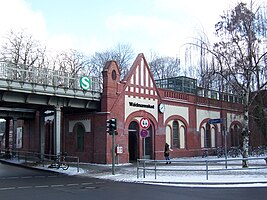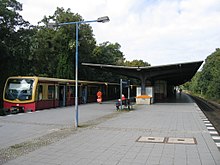Berlin-Waidmannslust train station
| Berlin-Waidmannslust | |
|---|---|
|
Station building
|
|
| Data | |
| Location in the network | Intermediate station |
| Design | Through station |
| Platform tracks | 2 |
| abbreviation | BWAI |
| IBNR | 8089092 |
| Price range | 4th |
| opening | May 20, 1884 |
| Website URL | sbahn.berlin |
| Profile on Bahnhof.de | Huntsmanship |
| Architectural data | |
| architect | Karl Cornelius , Doergé |
| location | |
| City / municipality | Berlin |
| Place / district | Huntsmanship |
| country | Berlin |
| Country | Germany |
| Coordinates | 52 ° 36 '23 " N , 13 ° 19' 16" E |
| Railway lines | |
|
|
| Railway stations in Berlin | |
The Berlin-Waidmannslust station is a S-Bahn station on the northern line . It is located in the center of the Berlin district Waidmannslust in the Reinickendorf district . The next train station to the north is Hermsdorf , the next train station to the south is Wittenau .
The S-Bahn station has a parking and turning facility , which is located north of the bridge over Waidmannsluster Damm on the former route of the long-distance railway tracks.
The main entrance to the reception building is at the northern end. This leads to Waidmannsluster Damm and a small forecourt on Jean-Jaurès-Straße, where there are bicycle parking spaces and a P&R car park. There are also bus stops here. Another entrance at the southern end of the platform leads into a pedestrian tunnel. This opens onto Am Waidmannseck to the east and Jean-Jaurès-Straße to the west, where there are further bicycle parking spaces.
history
On May 20, 1884, what was then the Waidmannslust colony received its own demand stop on the Berlin Northern Railway. This was financed by the forester and innkeeper Ernst Bondick, who drove the development and settlement of his lands during this time. Bondick was particularly clever here: on the day on which a trial count of the disembarking passengers was scheduled, he invited all acquaintances to his restaurant, so that the railway administration was impressed by the rush and set up continuous operation. Long before that, the Northern Railway had been running here between Berlin and Stralsund since 1877 . From 1891 the line was expanded to two tracks and raised to its current level between 1908 and 1912, with suburban tracks separated from the long-distance tracks between Gesundbrunnen and Frohnau . The station building and the bridges over Waidmannsluster Damm also date from this time and are now a listed building . On June 5, 1925, the steam trains were replaced by the electric S-Bahn, first to Birkenwerder , then later to Oranienburg .
On May 2, 1929, the extension of the tram route along the Wittenauer Cyclopstraße (today partly Jean-Jaurès-Straße) to Waidmannslust station was opened with line 68. With the increased discontinuation of bus lines due to the war, the repeater line 274 was added on October 16, 1939. Both lines then ran to the Waidmannslust station until July 1, 1942.
After 1945 the Wilhelmsruh –Birkenwerder section was reduced to one track each for long-distance and S-Bahn trains. Since there were no sidings along the route, the trains could initially only run every hour. It was not until 1948 that the clock was compressed to 20 minutes by two diversions in Waidmannslust and Frohnau. After 1952, long-distance traffic in the Berlin area was also given up, as the line was now in the western part of the city, but the tracks were not used for the expansion of the S-Bahn line.
When the Berlin Wall was built in 1961, the S-Bahn between the Frohnau and Hohen Neuendorf stations was interrupted. In the same year the southern entrance was bricked up. Despite the shrinking passenger numbers as a result of the S-Bahn boycott that began after 1961, operations along the northern line were maintained and even continued after the Reichsbahn strike in 1980 . The temporary shutdown only took place when the BVG took over the operating rights on January 9, 1984. Since the passengers spoke out in favor of operation with massive protests after the takeover, traffic to Frohnau was resumed on October 1, 1984. This only lasted until May 5, 1986, after which the line was comprehensively renovated and the second track was completely restored. The work was completed on December 22, 1986.
After German reunification , the gap across the West Berlin city limits between Frohnau and Hohen Neuendorf was closed, so that continuous S-Bahn operation on the northern line to Oranienburg has been possible again since May 31, 1992. The Reinickendorf district prevented a planned backfilling of the southern pedestrian tunnel by taking responsibility for it.
In 2001 the access structure was refurbished and almost returned to its original state. On January 29, 2007 an elevator was put into operation.
The electronic signal box Waidmannslust has been controlling the section between Schönholz (a) and Hohen Neuendorf (a) since October 2011. This is the first section to be converted to the new train control system of the S-Bahn Berlin (ZBS) . However, the control computer building is not located at Waidmannslust station, but at Hermsdorf station.
After several years of delays, the reconstruction of the previously closed southern platform access began in March 2012, in the course of which the stairs and their roofing were rebuilt. Access was granted at the end of the same year. 900,000 euros were invested for this.
Connection
In addition to the S-Bahn lines S1 and S26, the bus lines 222 and 322 as well as the night bus line N22 of the Berliner Verkehrsbetriebe stop at the station forecourt. The N20 night bus stops around 250 meters away at the corner of Waidmannsluster Damm and Oraniendamm.
literature
- Bernhard Strowitzki: S-Bahn Berlin - history (s) on the go . Verlag GVE, Berlin 2002, ISBN 3-89218-073-3 .
Web links
- Entry in the Berlin State Monument List
- Berlin-Waidmannslust train station at stadtschnellbahn-berlin.de
Individual evidence
- ↑ Station price list 2020. In: Deutsche Bahn. Deutsche Bahn, January 1, 2020, accessed on July 11, 2020 .
- ↑ Michael Günther: End of the line in the flowerbed. A chapter in tram history in Wittenau . In: Verkehrsgeschichtliche Blätter . Volume 2, 2009, p. 30-41 .
- ^ Wolfgang Kramer & Heinz Jung: Line chronicle of the electric tram in Berlin until 1945 . tape 3 , 1994, p. 30-41 .
- ↑ a b c Waidmannslust S-Bahn station again with a second access. Deutsche Bahn AG, December 20, 2012, archived from the original on February 15, 2013 ; Retrieved December 24, 2012 .
- ↑ New station management improves the image of Berlin's S-Bahn. Deutsche Bahn, February 7, 2002, accessed on February 16, 2012 .
- ^ Elevator in Waidmannslust S-Bahn station goes into operation. Deutsche Bahn, January 29, 2007, accessed on February 16, 2012 .
- ^ Main focus of construction in the S-Bahn network in 2011. Deutsche Bahn, September 1, 2011, archived from the original on December 28, 2011 ; Retrieved February 16, 2012 .

